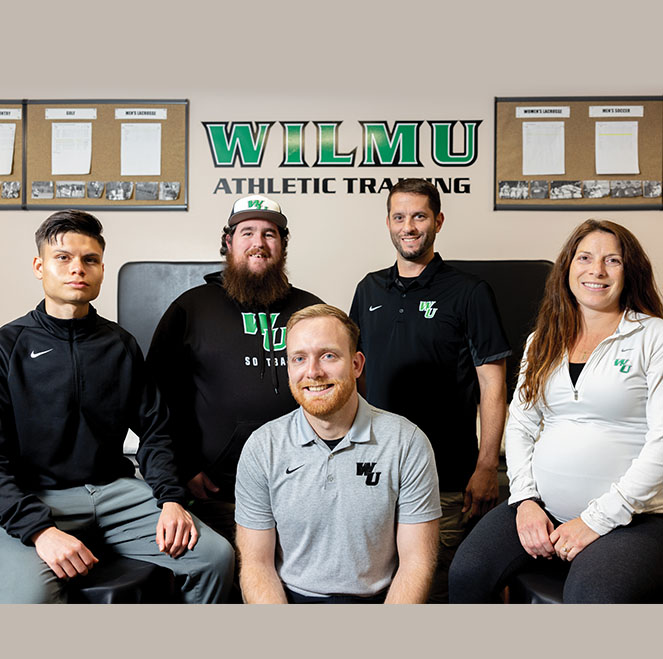
Wilmington University’s athletic trainers are a busy bunch. The University fields 16 teams — nine women’s and seven men’s — in NCAA Division II sports. An athletic trainer is present at every home contest, some of the away games or matches, and at every on-site, in-season practice.
“It can get hectic,” says Head Trainer Chris Stella. But he and his staff of one part-time and three full-time trainers manage their duties with skill, dedication, and enthusiasm.
And those duties are many, varied, and critical to the success of the University’s athletic program. Recognized by the American Medical Association (AMA) as an allied health care profession since 1990, athletic training requires skill in five domains of clinical practice: prevention; clinical evaluation and diagnosis; immediate and emergency care; treatment and rehabilitation; and organization and professional health and well-being.
Professional standards for athletic trainers are becoming more demanding. Says LaGwyn Durden, director of Sports Medicine at Sport Science Institute: “Emerging science has allowed for better understanding of how to address various injuries and reduce incidence. As such, athletic trainers need to find time in their already busy schedules for continuing education to ensure that they are providing care based on current industry standards of care and best practices.”
In the near future, all athletic training education programs must be at the master’s level in order to be accredited by the Commission on Accreditation of Athletic Training Education. Transition to this requirement has been gradual for the past seven years and will take full effect with incoming students during the next academic year, according to National Trainers’ Association President Dr. Kathy Dieringer.
She notes that the profession is expanding beyond the world of sports. “In the last decade or so, athletic trainers have found their way into a number of other settings,” she says. “They are working in performing arts, physician practices, military and industrial settings, hospitals, rehabilitation clinics, and in public safety, working with police and firefighters. There are so many opportunities out there.”
Stella, who marks 19 years as head trainer in 2023, says he and his staff typically work a six-day week. “Everyone picks their day off,” he says. It helps that his team works well together and exchanging shifts so someone can take off a specific day is common. Also, they get a bit of a breather in the summer, when no teams are in action.
He points out that there is a close-knit core of people in the Athletics Department “who have been here for a long time,” and the result is “a fun experience, a family atmosphere.”
Making up his immediate University family are full-time Assistant Trainers Dan Boeher, Amanda Denney, and Will Razzano, plus part-timer Luis Zamora Patino. All five have B.S. degrees in Athletic Training, and all sit for a board exam and have to be state licensed in order to practice.
Each member of the team has specific assignments, although all trainers are capable of covering any of the sports. In addition to his administrative duties, Stella, who has a master’s in Physical Therapy from the University of Delaware, covers volleyball, men’s and women’s cross country, men’s basketball, baseball, and golf. The entire staff splits up spring track and field.
The number one priority is preventing injuries. Nothing gladdens the heart of an athletic trainer like helping an athlete stay healthy throughout his or her season.”
Razzano, who has been on the staff since 2015, covers men’s soccer, softball, plus cheerleading, and he assists with women’s basketball and track and field. His workday varies depending on the season. “For example,” he says, “preseason soccer runs three-a-day practices — 8 a.m., 10 a.m., and 6 p.m. So, I’m in the office from 7 a.m. until about 9:30 p.m.”
On routine, non-game days, trainers write any injury notes, catch up on doctor or physical therapy appointments for the athletes, complete paperwork, and work on the athletes, who often fill the 10 training tables and four taping stations evenly split between two rooms — one at the Pratt Student Center and one at the Athletic Complex.
Over his two decades at the University, Stella has seen a significant upgrade in athletic training facilities. “We have high-end, Division I-type whirlpools, and the equipment in both rooms is excellent,” he says. “We try to use it as a recruiting tool.”
Game days are the most demanding. While players arrive at least an hour early, trainers arrive before that. Timing depends on the sport.
“For soccer, they get there an hour early,” says Razzano. “For softball, they start stretching about 2½ hours prior to the start time.”
When trainers arrive, they first gather the tools of their trade: Gatorade, cups, water bottles, ice chest, crutches, splint bag, defibrillator, medical kit, and the injury binder, in case anyone needs to be seen immediately due to injury. For soccer and lacrosse, these items are loaded into the Gator utility vehicle, which is also used to cart any injured players off the field.
“Post game is mostly cleanup and being available for anything that happened during the game,” says Razzano. “Afterward, we clean and wipe down the training room with disinfectant, change the pillowcases, and finish any team laundry and towels.”
Denney, the longest-tenured assist-ant trainer, joined the staff in 2008. She supports women’s soccer, women’s basketball, women’s lacrosse, and women’s bowling.
Admitting to an obsession with working out, Denney is a triathlete who completed the 2014 Ironman Lake Placid (New York) race. But even this Iron woman concedes that her work can be “very physical some days.”
“It seems we always have a new injury to evaluate and treat,” she says. “And we basically have one athletic trainer for each team, which means I will have to treat, by myself, possibly 10–15 athletes a day in the athletic training room.”
Yes, the job is demanding. “But,” says Boeher, “returning an injured athlete to play or helping an athlete feel better in order to help them compete is so satisfying.”
Adds Denney: “What I found to be the best part of my job is how grateful some athletes can be when you help them get back on that field.”
Boeher, who joined the staff in 2017, is responsible for men’s lacrosse as well as tennis, and also assists with track and field and men’s basketball. Because lacrosse is a contact sport, he must travel with the team to all away games. (In the other, non-contact sports, the home team’s trainer is responsible for the visiting team.)
For Denney and Boeher, life got a little more demanding in December, when they both became first-time parents.
Stella brought in Zamora Patino as a part-time assistant more than a year ago to work with the softball and baseball teams during their off seasons. As a runner and recreational soccer player, Zamora Patino says, “I understand the frustration that the athlete goes through when they’re medically unable to safely return to the sport that they love.”
He says his experience at WilmU will help him reach his career goal: working as an athletic trainer in Major League Soccer.
When they’re not icing down sore muscles or wrapping ankles (Stella estimates they used 3,800 rolls of tape/prewrap last year) trainers are treating ankle sprains, shin splints and knee problems. And the occasional concussion.
While lower-body injuries are the most frequent, Wildcat athletes also suffer the occasional concussion, even though the University doesn’t field a football team. In fact, Stella says, all sports — including bowling and golf — have recorded concussions. Some have occurred away from the sport, in the student-athlete’s everyday life, but all are treated by the athletic training staff.
“We’re very thorough and at the conservative end of the spectrum when it comes to concussions and return to play,” Stella says. “We treat them all the same. Every student goes through the same process. Basically, the person is resting until their symptoms clear.
“We inform their professors and get them extensions for class work. Returning the student to the classroom is the first priority. Once their symptoms resolve, we put them through a series of tests, both written and physical, then functional testing — running, sprinting — then they return to non-contact practice before upgrading to full contact.”
The mental health of athletes is another, and relatively new, area of concern for athletic trainers. “We were definitely in the forefront of this in 2017 when the NCAA recommended schools offer mental health counseling,” says Stella. “We started with one counselor and we’re now up to three, and we’re still trying to grow that pool.”
Stella says he and his staff work closely with Head Team Physician Dr. Joseph Straight in dealing with mental health issues. “Dr. Straight has some specialists working with him who help determine whether there will be treatment in house, treatment by the doctor, or referral to long-term treatment.”
Dr. Arlen Stone also treats WilmU athletes. His priorities are illnesses, general medicine, and urgent care issues.
What I found to be the best part of my job is how grateful some athletes can be when you help them get back on that field.”
— Amanda Denney
The entire sports medicine team stays in contact to plan each athlete’s progress through injury and rehabilitation. But, as Stella emphasizes, the number one priority is preventing injuries. Nothing gladdens the heart of an athletic trainer like helping an athlete stay healthy throughout his or her season.
Fortunately, since they spend so much time with athletes, the trainers are not only diligent and skilled professionals, they also are fans. Just ask the coaches.
Razzano, for instance, “loves the sport,” says Softball Head Coach Mike Shehorn.
Razzano plays softball in a local league, and he often brings his glove to practice. “He’ll come out and shag fly balls,” says Shehorn. “And at games, he’s just as much in the game as if he was a coach. The girls love him.”
Razzano is “fair and honest,” Shehorn says. “If he says they can’t play or practice that day, the players respect him and accept that.”
Christian Zwickert, head men’s lacrosse coach, says Boeher “is one of our biggest supporters, not only in the physical aspect, but also in dealing with mental health issues. Dan is the first step in creating mental health support for the guys. They absolutely love him and trust him.”
As Zwickert points out, men’s lacrosse is the only sport “where a piece of equipment can be used to hit another player,” so injuries are fairly frequent, and the athletic trainer becomes all-important.
“In the training room, Dan is boss,” Zwickert says. “Every day after practice he gives me clinic notes, basically an update as to injuries and treatment. He even attends some coaches’ meetings.”
Kevin Day, head coach of women’s lacrosse, says Denney is “absolutely phenomenal. She’s very thorough and caring. She’s almost like a big sister to the girls.”
On road trips, Day and Denney sometimes work out together at the local YMCA. Well, not exactly together. Day, a competitive power lifter, is usually done long before Denney, who often hits the treadmill, the stationary bike, and the pool in her workouts.
The trainers regularly join their teams in celebrating victories, which the Wildcats did a lot of in the 2021–22 academic year. They came out on top 65% of the time — 174 out of 266 contests. And while players and coaches rightly deserve most of the glory, some of it should go to Chris Stella and his skilled staff.
— Bob Yearick



